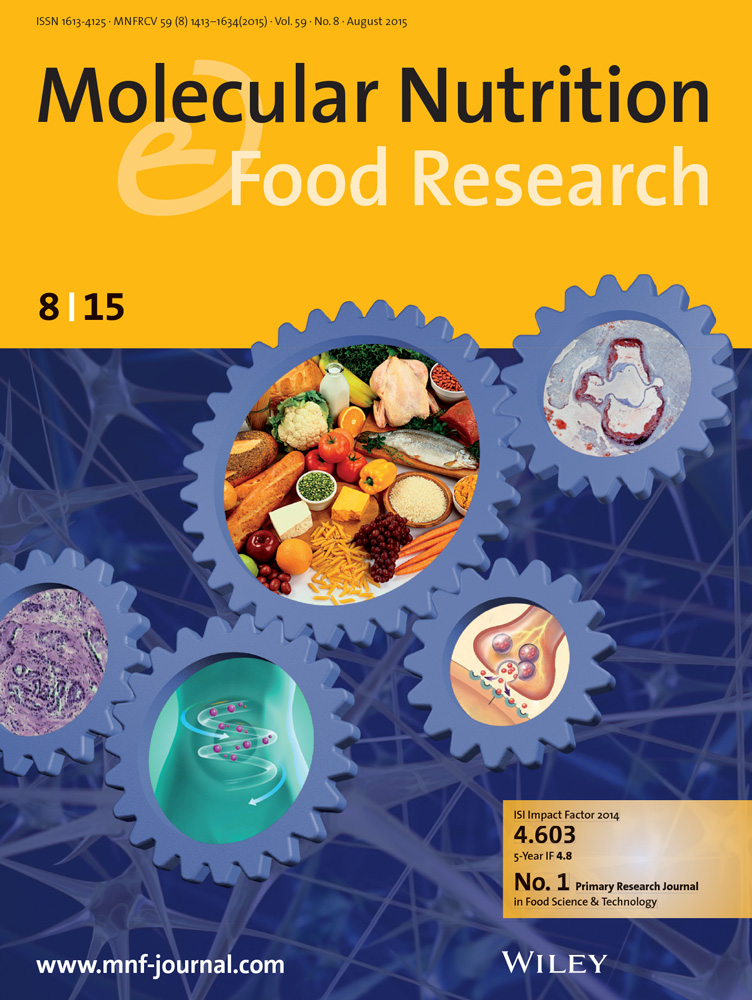补充罗伊氏乳杆菌(Limosilactobacillus reuteri) TISTR 2736减轻高胆固醇饮食大鼠血管损伤和氧化应激
IF 4.5
2区 农林科学
Q1 FOOD SCIENCE & TECHNOLOGY
引用次数: 0
摘要
高脂血症和氧化应激与动脉粥样硬化性心血管疾病有显著关系。益生菌补充剂已被证明可以降低高脂血症,并可能降低动脉粥样硬化的风险。本研究旨在评价罗伊氏乳杆菌(Lactobacillus reuteri) TISTR 2736 (LR)对高胆固醇饮食(HCD)诱导的高脂血症大鼠血管损伤的治疗能力,并阐明其可能的机制。雄性Sprague-Dawley大鼠给予标准饮食或HCD, HCD喂养的大鼠口服LR (2 × 108 CFU/大鼠/天),持续8周。与饲喂HCD组相比,LR降低了血清TC、TG、LDL和内皮素- 1水平,但升高了主动脉一氧化氮和血清HDL水平。此外,LR逆转了HCD诱导的主动脉组织学改变。大鼠主动脉黏附分子(VCAM‐1和ICAM‐1)、凝集素样氧化低密度脂蛋白受体‐1 (LOX‐1)、NADPH氧化酶亚基p47phox、eNOS单体/二聚体比、氧化应激标志物(4 -羟基壬烯醛和3 -硝基酪氨酸)和促炎性细胞因子(TNF‐α和IL‐6)的蛋白水平降低,而核因子红系2相关因子2 (Nrf2)和血红素加氧酶‐1 (HO‐1)的蛋白水平和超氧化物歧化酶活性均升高。这些发现表明,补食LR可改善HCD诱导的血管功能障碍和炎症,可能是通过降低高脂血症、抑制ROS生成和增加抗氧化酶活性来实现的。本文章由计算机程序翻译,如有差异,请以英文原文为准。
Lactobacillus reuteri (Limosilactobacillus reuteri) TISTR 2736 Supplementation Attenuates Vascular Injury and Oxidative Stress in Rats Fed a High‐Cholesterol Diet
Hyperlipidemia and oxidative stress are significantly related to atherosclerotic cardiovascular disease. Probiotic supplements have been demonstrated to reduce hyperlipidemia and might minimize atherosclerotic risk. This study aimed to evaluate the therapeutic ability of Lactobacillus reuteri TISTR 2736 (LR) on vascular damage in high‐cholesterol diet (HCD)‐induced hyperlipidemic rats and elucidate their possible mechanisms. Male Sprague–Dawley rats received a standard diet or HCD, and LR (2 × 108 CFU/rat/day) was orally administered to HCD‐fed rats for 8 weeks. Compared to the HCD‐fed group, LR administration reduced serum levels of TC, TG, LDL, and endothelin‐1 but elevated levels of aortic nitric oxide and serum HDL. Additionally, LR reversed the HCD‐induced aortic histological changes. The protein levels of adhesion molecules (VCAM‐1 and ICAM‐1), lectin‐like oxidized low‐density lipoprotein receptor‐1 (LOX‐1), NADPH oxidase subunits p47phox , eNOS monomer/dimer ratio, oxidative stress markers (4‐hydroxynonenal and 3‐nitrotyrosine), and pro‐inflammatory cytokines (TNF‐α and IL‐6) were decreased, while those of nuclear factor erythroid 2‐related factor 2 (Nrf2) and heme oxygenase‐1 (HO‐1), and the activity of superoxide dismutase were increased in the aortas of LR‐treated rats. These findings suggest that LR supplementation ameliorates HCD‐induced vascular dysfunction and inflammation, possibly by lowering hyperlipidemia, suppressing ROS production, and increasing antioxidant enzyme activities.
求助全文
通过发布文献求助,成功后即可免费获取论文全文。
去求助
来源期刊

Molecular Nutrition & Food Research
工程技术-食品科技
CiteScore
8.70
自引率
1.90%
发文量
250
审稿时长
1.7 months
期刊介绍:
Molecular Nutrition & Food Research is a primary research journal devoted to health, safety and all aspects of molecular nutrition such as nutritional biochemistry, nutrigenomics and metabolomics aiming to link the information arising from related disciplines:
Bioactivity: Nutritional and medical effects of food constituents including bioavailability and kinetics.
Immunology: Understanding the interactions of food and the immune system.
Microbiology: Food spoilage, food pathogens, chemical and physical approaches of fermented foods and novel microbial processes.
Chemistry: Isolation and analysis of bioactive food ingredients while considering environmental aspects.
 求助内容:
求助内容: 应助结果提醒方式:
应助结果提醒方式:


